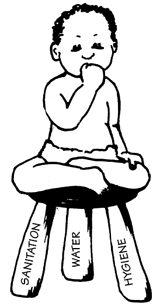by Richard Franceys.
We all know that water is a wonderful gift. It falls as rain and collects in streams and rivers or under the ground. From there we can take it for drinking, for cooking, for bathing and for washing pots and pans and clothes.
We must have water for life. We all have some form of water supply already – if we didn’t we couldn’t live. But many of us would like to have a better quality water supply closer to home. This is what costs money.
For health!
To spend this money, government or aid projects need to prove that supplying clean water brings benefits which can be measured. The most obvious benefit is improved health. None of us want our children or weaker relatives to suffer from diarrhoeal diseases such as dysentery and cholera. The World Health Organisation tell us that over 3 million children die each year through diarrhoeal disease. But the significant reduction in disease that can result from improving the water supply only occurs when sanitation and hygiene education are also improved.
Like the three legs of a stool or the three stones which support the cooking pot over the fire, we need three related things to reduce disease in our families…
- clean water supply
- effective hygiene behaviour (particularly the use of soap and water for handwashing and clean containers for collecting and storing water)
- safe disposal of human wastes (sanitation).
UNICEF has estimated that it is possible to reduce child deaths from diarrhoea by a quarter if all these three things are encouraged in a community. Improvements in sanitation and hygiene each contribute to about 35% of the reduction. Surprisingly, increasing water quantity contributes only 20% and ‘safe’ water quality contributes only 15% of the beneficial effect. In this edition of Footsteps we have articles about all of these ‘legs’.
Water supply
Having more water closer to home not only improves health but also reduces the long time spent by so many women and children in collecting water. One improvement is to build a water tank for use by homes, clinics or schools. Details are included in article 'Ferro cement tank' in this issue.
Hygiene behaviour
A latrine and hand pump project in Bangladesh spent nearly a quarter of its budget on hygiene education. This is very much more than most projects, which choose to put nearly all their resources into pipes and pumps. However, the result was that incidence of diarrhoea fell by a quarter and that the number of days on which the average child suffered from diarrhoea almost halved. We look at this very important and often over-looked subject on page 4. Water supply and sanitation on their own are not enough.
Sanitation









